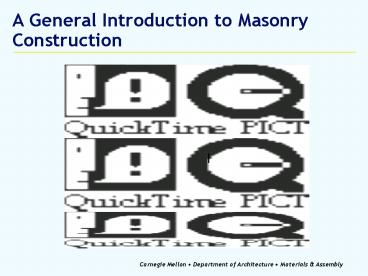A General Introduction to Masonry Construction - PowerPoint PPT Presentation
Title:
A General Introduction to Masonry Construction
Description:
... Boston (1872) Indiana Statehouse/ Chicago City Hall High-rise Empire State/Tribune Tower Seasoning: Contains water known as quarry sap. – PowerPoint PPT presentation
Number of Views:128
Avg rating:3.0/5.0
Title: A General Introduction to Masonry Construction
1
A General Introduction to Masonry Construction
2
Topics
- Unit Types
- Brick Concrete Masonry Units
- Stone Glass Block
- Mortar
- Physical Properties Technical Data
- Three Dimensional Masonry Structures
- Walls Openings
- Single Multiple Wythe
- Monolithic and Composite
- Reinforced (Engineered) Masonry
3
A Generic Definition for Masonry Construction
- A variety of formations consisting of separate
elements held together with a binder - elements
- stone, fired clay elements, concrete, glass,
adobe - binder
- mud, lime mortar, cement mortar
4
Potential Advantages of Masonry Construction
- simple
- materials at hand
- less bracing formwork than concrete.
5
Potential Disadvantages of Masonry Construction
- labor intensive
- compressive capacity only
- skilled labor
- mortar shrinkage
- thermal exp/contr
6
Bricks
7
Brick Manufacturing
- Stiff Mud - Extrusion Process
- Soft Mud - Molding Process
8
Brick Classification
- ASTM C216 Facing Brick
- Other Classifications Exist for
- Building Brick
- Hollow Brick
- Paving Brick
- Glazed Ceramic Brick
- Thin Brick Veneer Units
- Sewer Brick
- Chemical Resistant and Industrial Floor Bricks
9
Brick Selection
- Aesthetics
- Size
- Color
- Texture
- Shapes
- Cost
- Availability
10
Physical Properties
- Compressive Strength
- Durability
- Absorption
- Abrasion Resistance
11
Factors to Consider in Application
- Moisture Penetration
- Temperature Variation
- Structural Loading
12
Weathering Grades ASTM C216
13
Face Brick Grades ASTM C216
- FBX tightest tolerance, 5/32"
- FBS less tolerance, 1/4"
- FBA loosest tolerance, not specified
14
Basic Terminology
- Course continuous horizontal layer of masonry
units - Wythe continuous vertical section of masonry
one unit in thickness
15
Brick Course, Wythe Joints
16
Brick Dimensional Data
- Standard Modular
- Face Dimension 2 2/3" x 8" nominal
- Thickness 4" nominal
- Mortar Joint 3/8"
17
Modular Brick Coursing Dimensions
18
Brick Positions in a Wall
19
Concrete Masonry Units
20
Concrete Masonry Unit Manufacturing
21
Concrete Masonry Unit Classification
- ASTM C90 Load-Bearing Concrete Masonry Units
- ASTM C129 Non-Load-Bearing Concrete Masonry
Units - ASTM C55 Concrete Building Brick
22
Concrete Masonry Unit Selection
- Aesthetics
- Color
- Texture
- Shapes
- Function
- Strength
- Shape
23
Factors to Consider in Application
- Exposure Condition
- Moisture Penetration
- Temperature Variation
- Structural Loading
24
Physical Properties
- Moisture Content
- Absorption
- Face and Web Thickness
- Compressive Strength
25
Concrete Masonry Unit Classifications ASTM C90
- Type I Moisture Controlled
- Type II Non-Moisture Controlled
26
Strength and Absorption Requirements ASTM C90
27
Concrete Masonry Unit Modular Coordination
28
Concrete Masonry Unit Basic Shapes
29
More Basic Shapes I
30
Stone
31
Stone Types
- Primary
- Secondary
- Metamorphic
32
Primary
- Igneous
- granite
- hard / no cleavage
33
Secondary
- Sedimentary
- disintegration - sandstone
- reconsolidation - limestone
- easy to saw or split
34
Limestone
- First quarried in South Indiana in 1827
- Demand coincided with growth of the RR
- Gang saws were introduced to slice slabs
- Fires in Chicago (1871) Boston (1872)
- Indiana Statehouse/ Chicago City Hall
- High-rise Empire State/Tribune Tower
35
Seasoning
- Contains water known as quarry sap.
- Minimum 6-month seasoning.
- Difficult to finish after seasoning.
36
Metamorphic
- Sedimentary converted by heat pressure
- marble
- high compressive strength
- low tensile strength.
37
Quarrying Techniques for Stone
38
Production sizes shapes
- floor to floor panels
- blocks
- sills
- copings
- entrance features
39
Compressive Strength Density
40
Mortar
41
Mortar Functions
- Bonding
- Sealing against Air and Water
- Accommodating Small Movements
- Leveling
- Securing Reinforcement
42
Properties of Plastic Mortar
- Workability
- Spreads Easily
- Adheres to Vertical Surfaces
- Supports the Weight of the Units
- Maintains Position
- Water Retention
- Re tempering is Permissible to Maintain
Workability
43
Mortar
- ASTM C270
- Four Types M, S, N, O
- Cement, Lime, Fine Aggregate (sand), Water
44
Proportion Strength Specifications

